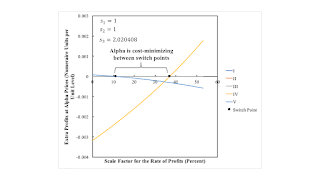| Figure 1: Wage Curves and Rent for an Example of Intensive Rent |
The first man who, having enclosed a piece of ground, bethought himself of saying, 'This is mine', and found people simple enough to believe him, was the real founder of civil society. From how many crimes, wars and murders, from how many horrors and misfortunes, might not anyone have saved mankind by pulling up the stakes, filling in the ditch, and crying to his fellows, 'Beware of listening to this imposter; you are undone if you once forget that the fruits of the earth belong to us all, and the earth itself to nobody.' -- Jean Jacques Rousseau1.0 Introduction
This post is a continuation of a previous example. Three commodities, iron, steel, and corn, are produced commodities. A single type of land exists, and three processes are available for producing corn on land.
The choice of technique corresponds to the selection of which processes are used in agriculture. Only the Alpha, Delta, and Epsilon techniques are feasibles for the given endowment of land and the requirements for use. Under Alpha, the land is only partially farmed. Land is not scarce and obtains no rent. Under Delta and Epsilon, the land is fully farmed, with two corn-producing processes being operated side-by-side. The second of these processes varies between Delta and Epsilon.
2.0 Choice of TechniquePrices of production are assumed to prevail, but markups over costs vary between industry and agriculture.
Figure 1 illustrates the wage and rent curves for this example. For a non-negative scale factor for the rate of profits up to the first switch point point, the Epsilon technique is cost-minimizing. At this switch point, the rent on land for Epsilon is zero, while it is positive for any smaller non-negative scale factor. This switch point is a fluke in that it is also the scale factor for the rate of profits at which the wage first turns positive for the Delta technique.
Between this first switch point and the switch point between Alpha and Delta, both the Alpha and Delta techniques are cost-minimizing. At the second switch point, the rent on land for Delta is zero. For a scale factor somewhat larger than at this switch point, no technique is cost-minimizing. Delta and Epsilon are feasible, but rent is negative for both of them. The wage for Epsilon is also negative. Alpha, on the other hand, is feasible, can pay a positive wage, and has a non-negative (zero) rent. Prices of iron, steel, and corn for Alpha are also positive in this range. Yet Alpha is not cost-minimizing.
| Lower Bound on r | Upper Bound on r | Techniques |
| 0 percent | r* | Alpha has a positive wage |
| Delta has a negative wage | ||
| Epsilon has a positive wage and positive rent | ||
| Epsilon is uniquely cost-minimizing | ||
| r* | r** | Alpha has a positive wage |
| Delta has a positive wage and positive rent | ||
| Epsilon has a positive wage and negative rent | ||
| Alpha is non-uniquely cost-minimizing | ||
| Delta is non-uniquely cost-minimizing | ||
| r** | rα, max | Alpha has a positive wage |
| Delta has negative rent | ||
| Epsilon has negative wage and negative rent | ||
| No cost-minimizing technique exists |
Table 1 summarizes these claims about which techniques are cost-minimizing for which ranges of the scale factor for the rate of profits. Figure 2 graphs extra profits for each process at Alpha prices. Extra profits are the difference bewteen the price of the commodity produced by the process and the costs for commodity inputs, rent, and wages. The costs of inputs of iron, steel, and corn incur the going rate of profits for that industry, including markups. Extra profits can be positive or negative. As a check on the calculations, one can maybe see from the graph that extra profits are zero, neither positive nor negative, for the three processes comprising the Alpha technique. For a non-negative scale factor less than at the first switch point, extra profits can be made at Alpha prices by growing corn with the fifth process in the technology. For a scale factor exceeding that at the second switch point, but below the maximum, extra profits are obtained by growing corn with the fourth process in the technology. Thus, Alpha is only cost-minimizing between the switch points.
| Figure 2: Extra Profits with Alpha Prices |
Figure 3 shows the extra profits obtained for each process for the Delta and Epsilon techniques, in the left and right panes respectively. Extra profits are only graphed for each for the range of the scale factor for the rate of profits for which both the wage and rent is non-negative. Since four of the five processes are operated in Delta, or in Epsilon, extra profits are non-zero for only one process in each graph. And you can see both techniques are cost-minimizing for the full range of the graphed scale factor in each case.
| Figure 3: Extra Profits with Delta or Epsilon Prices |
3.0 Conclusion
For a markup in agriculture slightly lower than for the fluke case, a range of the scale factor for the rate of profits exists in which the Delta and Epsilon techniques are both cost-minimizing. For a markup slightly higher, no such range, not even a single point, exists. For the whole range of the scale factor in which the Delta technique exhibits a positive rate of profits and a positive rent, the Alpha technique is also cost-minimizing. And when the Alpha technique is cost-minimizing, the class of landlords cannot exist.






No comments:
Post a Comment